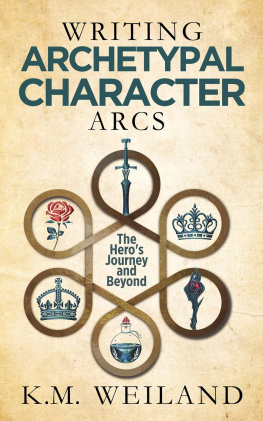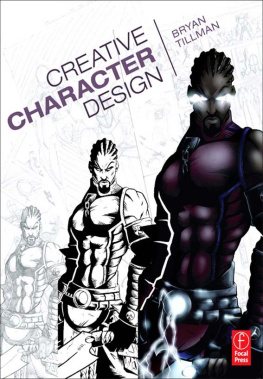Contents
WRITING ARCHETYPAL CHARACTER ARCS:
The Heros Journey and Beyond
K.M. Weiland
PenForASword Publishing

Get a free copy of acclaimed writing teacher K.M. Weilands guide to advanced story structure techniques.
Click here to get started:
https://www.kmweiland.com/get-your-free-guide/
Archetypal Character Arcs Are the Key to Deep and Resonant Fiction
Experiencing an archetypal story is transformativelike suddenly remembering something you always knew but somehow forgot. Writing archetypal stories, however, can sometimes be confusing. Either archetypes seem way too limiting (i.e., the Heros Journey and only the Heros Journey), or they seem far too varied to create a sensible or cohesive system.
This book ventures far beyond the popular and pervasive Heros Journey to explore twenty-four primary archetypes of the human life cycle. At the core of the system are six sequential positive character arcs representing key moments of initiation and transformation:
- The Maiden
- The Hero
- The Queen
- The King
- The Crone
- The Mage
This cycle also explores twelve possible shadow archetypes, six resting archetypes, and twelve archetypal antagonists.
Writing Archetypal Character Arcs will teach you:
- Which archetypes are right for your particular story
- The best way to use archetypes in a series
- How to choose the right archetypes for supporting characters
- How to use archetypes to identify your storys theme
Archetypes will change the way you view storyand lifeforever.
Introduction
Archetypal Character Arcs and the Search for Meaning
There are as many archetypes as there are typical situations in life. Endless repetition has engraved these experiences into our psychic constitution.
C.G. Jung
STORIES HAVE BEEN our constant companions throughout the journey of human existence. Why is that? Is it because they entertain us? Is it because they inform us? Because they distract us?
Yes, of course. But the very universality of, not just story itself, but our passionate connection to story would seem to indicate the human experience finds great resonance in the act of storytelling.
I do not think it too simplistic or idealistic a statement to say that storytelling is a quest for meaning. As creators and consumers of story (and, indeed, art as a whole), we all have personal connections to this. We often interact with stories, whether intellectually or emotionally, as a search for understanding. We turn to stories for catharsis, comfort, and catalytic challenge.
As writers, we gradually become more cognizant of this than even the average viewer or reader. As we study the craft and technique of writing, we eventually encounter humanitys collective ideas of story theory. These theories posit that there are certain patternswhich we generally identify by such terms as story structure and character arcthat repeat themselves over and over again to create the very definition (however loose) of what we consider a story at all.
When writers begin learning story theory principles, we often tend to identify them merely as rules for success. But in recognizing that story itself is archetypal, these tools and techniques of the craft begin to emerge as a fascinating meta commentary on the deeper questions of life itself.
The Cosmology of Story Theory
Before diving into the nitty-gritty of foundational archetypal characters and character arcs (including but going far beyond the prevalent Heros Journey), I want to step back to the broader context. In Chapter 1, well be talking more specifically about actual archetypes in fiction. But first, I want to talk about story itself as archetype.
Several years ago at a time when I was particularly needing, searching for, and redefining meaning in my own life, I read Madeleine LEngles wonderful ode to the synthesis of art and spirit, Walking on Water . I resonated deeply with her notion of why it is that humans are driven to create and to tell stories. She recognized art as an ordering principle by which humankind strives to understand its own existence, referring to it by Carl Jungs phrase cosmos in chaos. The more I study story theory, the more I have come to recognize it as something of a cosmology all its owna microcosmic commentary on existence.
In short: an archetype.
What is an archetype? My dictionary offers three definitions:
A typical specimen.
An original model.
A universal or recurring symbol.
When what we write touches upon that which is archetypal (sometimes consciously, usually unconsciously), it is often surprisingly explicit in its ability to offer us answers and meaning in our questions about life.
For example, modern writers often tend to think of story structure as a format we apply to our stories. But, in fact, story structure is an emergent . It exists and it worksand we recognize it as such and try to engineer it into our own storiesbecause it reflects truthful patterns about life itself. The same is true, perhaps even more poignantly, for character arcs. For me, researching and writing my previous book Creating Character Arcs was a personally life-changing experience that provided insights far beyond writing. The reason character arcs resonate with us as readers and viewers is that they are patterns within our own lives .
And so it goes for even more mythic archetypal journeys, such as the Heros Journey made so famous and ubiquitous by Joseph Campbell and George Lucas. These mythic story structures are endlessly repeatable because they do endlessly repeat in every single one of our lives.
Meanings, Patterns, Symbols, and Archetypes
Story theory is eminently practicable in supplying writers with techniques they can apply to improve the resonant power, and therefore success, of their stories. But this is really just a byproduct of the theory itself, which focuses on recognizing emergent patterns within our ever-growing body of stories. These patterns then contribute to our ability to recognize those particular symbols and archetypes that appear over and over again, almost universally, rising far above time, place, genre, or even thematic intention.
At their loftiest, the emergent patterns of human stories tell us something about all of existence. Usually, however, these patterns are most poignant when they help us tell our own stories, not just those we put on paper, but those we are living every moment of every day.
We may think of stories as something separate and apart from life itself, particularly in this day and age when stories are more accessible and abundant than ever and we most commonly interact with them with the intention of entertainment or distraction. But inevitably story is not separate. Indeed, perhaps the modern era has seen the line between story and reality grow more blurred and meta than ever. When we understand the symbiosis of art and life, we are able to simultaneously bring the patterns of life to the page and the patterns of the page to our lives.
Humans interact with stories for many reasons, all of them valid. But deeper than the entertainment, the distraction, or the titillationdeeper than the characters, the character arcs, and the plot structurethere is the resonance of story itself as a foundational archetypal reflection.
All art is necessarily both reflective and generative of the human experience. In that way, all art both reflects and generates archetype. Some stories do this more simply and obviously than others. Those stories that we recognize as myth or fable are most blatantly archetypal. But even hyper-realistic storieswhen well doneoffer up to us the archetypal truths of humanity.
















